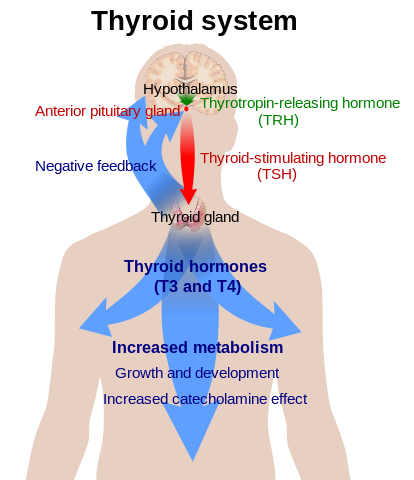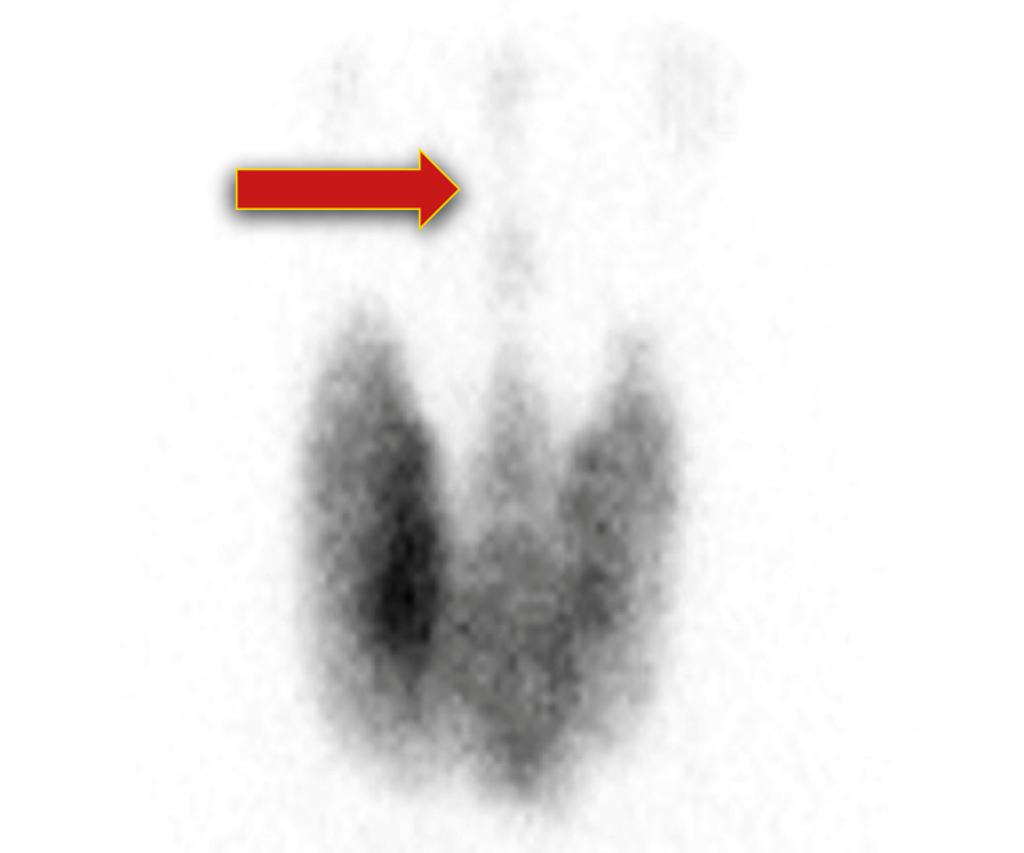Sandbox: hyperthyroidism landing: Difference between revisions
Ahmed Younes (talk | contribs) |
Ahmed Younes (talk | contribs) No edit summary |
||
| Line 246: | Line 246: | ||
*Hyperthyroidism due to ectopic thyroid tissue | *Hyperthyroidism due to ectopic thyroid tissue | ||
<br> | <br> | ||
<br> | |||
==Pathophysiology== | ==Pathophysiology== | ||
* Thyroid hormones (T3 and T4) are regulating basal metabolic rate, influence oxygen consumption by tissues. They are crucial for normal development of the brain and growth of the body especially in prepubertal period. | * Thyroid hormones (T3 and T4) are regulating basal metabolic rate, influence oxygen consumption by tissues. They are crucial for normal development of the brain and growth of the body especially in prepubertal period. | ||
Revision as of 17:40, 6 July 2017
Template:Hyperthyroidism landing
Editor-In-Chief: C. Michael Gibson, M.S., M.D. [1];Associate Editor(s)-in-Chief: Ahmed Younes M.B.B.CH [2]
Overview
Causes
Major causes in humans are:
Other causes of hyperthyroxinemia (high blood levels of thyroid hormones) are not to be confused with true hyperthyroidism and include subacute and other forms of thyroiditis (inflammation) and struma ovarii (a teratoma). Thyrotoxicosis (symptoms caused by hyperthyroxinemia) can occur in both hyperthyroidism and thyroiditis. When it causes acutely increased metabolism, it is sometimes called "thyroid storm", a life-threatening event characterized by tachycardia, hypertension, and fever.
Excess thyroid hormone from pills can also cause hyperthyroidism. Amiodarone, a heart medication, can sometimes cause hyperthyroidism. Hamburger toxicosis is a condition that occurs sporadically and is associated with ground beef contaminated with thyroid hormone.
Postpartum thyroiditis occurs in about 7% of women during the year after they give birth. PPT typically has several phases, the first of which is hyperthyroidism. Many times, the hyperthyroidism corrects itself within weeks or months without any treatment necessary.
Life Threatening Causes
- Adenocarcinoma
- Choriocarcinoma
- Metastatic follicular thyroid cancer
- Pituitary tumor
- Struma ovarii
- Teratoma
- Testicular cancer
- Thyroid adenoma
- Thyroid carcinoma
- Thyroid nodule
- Thyroid tumor
- Thyrotropinoma
- Toxic adenoma
- Toxic thyroid adenoma
- Trophoblastic disease
- Tsh-producing pituitary adenoma
Common Causes
Causes by Organ System
Causes in Alphabetical Order
Calssification
Hyperthyroidism can be classified according to the results of iodine uptake test into:
High iodine uptake
- Grave’s disease
- Toxic multinodular goiter
- Toxic thyroid adenoma
High or normal uptake:
![Normal thyroid scan - Myohan at en.wikipedia [CC BY 3.0 (http://creativecommons.org/licenses/by/3.0)], via Wikimedia Commons](/images/e/e0/Thyroid_scan.jpg) |
- Iodine caused hyperthyroidism
- Hashitoxicosis
- Germ cell tumors (choriocarcinoma in males and testicular germ cell tumors)
- Pituitary TSH-producing adenoma
Low uptake
- Subacute thyroiditis
- Hyperthyroidism due to ectopic thyroid tissue
Pathophysiology
- Thyroid hormones (T3 and T4) are regulating basal metabolic rate, influence oxygen consumption by tissues. They are crucial for normal development of the brain and growth of the body especially in prepubertal period.
- Secretion of thyroid hormones follows upper control from the hypothalamus and the pituitary. Thyroid releasing hormone (TRH). TRH acts on thyrotropes releasing cells in the pituitary causing them to release thyroid stimulating hormone (TSH).
 |
- TSH acts on thyroid gland by binding to specific membrane receptors and activating an intracellular pathway involving cAMP that ends in formation and secretion of thyroid hormones.
- Iodine is essential for synthesis of thyroid hormones. The daily iodide need is about 100mcg / day. Iodide is uptaken through a special Na/I transporter found in the membrane of thyroid follicular cell. After uptaking iodide, it goes through a series of organic reactions ending in the formation of the two forms of thyroid hormones :T3 and T4. T3 and T4 remain stored in the thyroglobulin of the follicles and are released in response to further stimulation by TSH to the thyroid follicles.
- While T3 is 3 to 5 times more potent than T4, it represents only one fourth of the total hormone secretion. T3 is thought to be the biologically active form of the of the two forms of the hormone. Most of the circulating T3 is due to peripheral conversion of T4 in the liver and peripheral tissues while only a small percentage is secreted directly from the thyroid gland itself.
- T3 and T4 act on nuclear receptors (DNA binding proteins) and cause the regulate the transcription of many proteins to regulate the metabolic rate of the body.
- The higher regulation of thyroxin secretion follows the negative feedback role, meaning that high levels of T3 and T4 will suppress TRH and TSH secretion and vice versa (Low levels of thyroxins will stimulate TRH and TSH secretion). This is useful in diagnosing the cause of hyperthyroidism (in secondary hyperthyroidism where the pituitary or the hypothalamus are the source of the disease. TSH will be high, while in primary hyperthyroidism where gland is the source of the excess hormones, TSH will be low).
- In grave’s disease, the most common cause of hyperthyroidism. The disorder lies in the secretion of thyroid stimulating antibodies (TSI) that work on thyroid follicular cells causing excessive uncontrolled release of the thyroxins. TSI responsible for many other aspects of the disease such as ophthalmopathy and the skin manifestations. This is thought to be due to the epitopic similarity between antigens on the surface of these cells and the thyroid receptors.
- The majority of circulating T3 and T4 are bound to plasma proteins and thus not active (T4 is mostly bound to thyroxine binding globulin and T3 is mostly bound to transthyretin). Conditons that impair the production of thyroid binding globulins (such as pregnancy, liver failure and certain drug administration) cause a change in the total serum thyroxins but the free T3 and T4 remain normal and patient remains euthyroid (this carries only laboratory significance).

